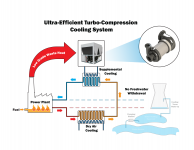Ultra-Efficient Turbo-Compression Cooling

Technology Description:
Colorado State University (CSU) and its partners, Modine and Barber-Nichols, will develop a thermally powered supplemental cooling system for thermoelectric power plants that will enable dry cooling. The technology features a transformational turbo-compressor and low-cost, high-performance heat exchangers that are currently mass produced for the HVAC industry. To operate, low-grade waste heat from the power plant combustion exhaust gases, or flue gas, is captured and used to power a highly efficient turbo-compressor system. The compressor pressurizes vapor in a refrigeration cycle to remove up to 30% of the power plant cooling load. The cooling system utilizes proprietary technology to maximize the turbo compressor and total system efficiencies, enabling a low production cost and an overall smaller, less expensive dry-cooling system. As a result, the cooling system could allow thermoelectric power plants to maintain a high efficiency while eliminating the use of local water resources. Furthermore, due to its very high performance, the turbo-compression cooling system has potential applications in a range of other markets, including commercial HVAC systems, data center cooling, and distributed cooling industries.
Potential Impact:
If successful, CSU and its partners will develop a supplemental cooling system that can efficiently remove up to 30% of the cooling load, helping to maintain the thermal efficiency of an air-cooled power plant.
Security:
The team’s dry-cooling system could help maintain power plant energy efficiency by providing a low-cost alternative to water cooling when water use is restricted.
Environment:
When combined with dry-cooling technologies, the team’s system can eliminate the need for local water resources to generate power and help conserve water for other uses.
Economy:
By integrating mass-produced heat exchangers and highly efficient turbomachinery, the system could be significantly cheaper than conventional dry-cooling systems.
Contact
ARPA-E Program Director:
Dr. Michael Ohadi
Project Contact:
Dr. Todd Bandhauer
Press and General Inquiries Email:
ARPA-E-Comms@hq.doe.gov
Project Contact Email:
tband@engr.colostate.edu
Partners
Barber Nichols
Modine Manufacturing Co.
Related Projects
Release Date:
09/26/2014
